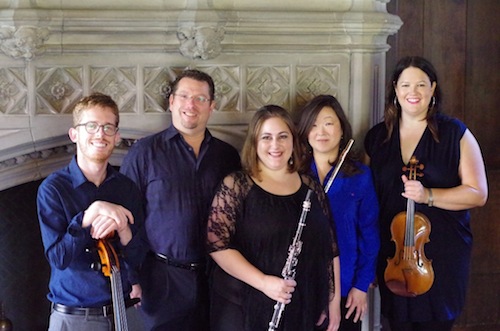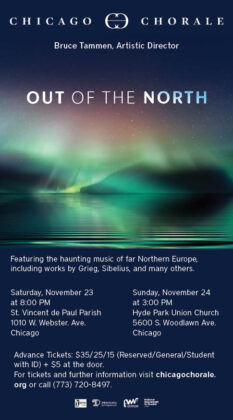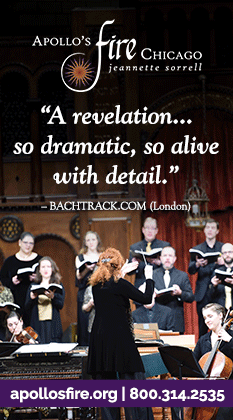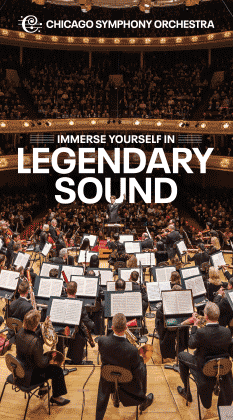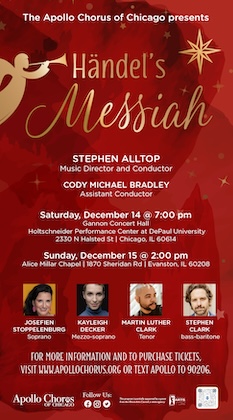Picosa explores the music of Augusta Read Thomas
Monday night, the Picosa ensemble presented a program at PianoForte Chicago centered on the music of Augusta Read Thomas. The Picosa musicians offered dedicated readings of a handful of the composer’s works from about ten to fifteen years ago, with additional selections from other composers whose work influenced Thomas, the Chicago Symphony Orchestra’s former, longest-serving composer-in-residence.
None of the Thomas works on the program ran longer than about six minutes, each selection something of a distillation of the composer’s heady idiom. …a circle around the sun… for piano trio, opened with the strings probing a static, fundamental pitch of G-natural, the explorations adorned with harmonic color commentary from the piano. A more pointillistic second section was delivered with incisive precision, performed by Picosa members, cellist Chris Ferrer and pianist Jeffrey Panko with guest violinist Jennifer Leckie.
Flutist Jennie Brown and Panko offered a sensitive reading of the birdsong-infused La merle noir of Olivier Messiaen before the ensemble returned to Thomas with her Capricci – “Hummingbird Romance” for flute and clarinet, a vignette marked by jazz influences. Brown and clarinetist Andrea R. DiOrio successfully created a sense of controlled improvisation in the dialogic work, DiOrio demonstrating solid command of extended instrumental techniques.
The two-minute-long Euterpe’s Caprice for solo flute sounded remarkably similar to the previous work despite its wildly different inspiration, and Brown’s rendition was stylistically suitable despite minor lapses in tone and pitch at the ends of phrases.
The first half closed with Joan Tower’s Petroushskates. As indicated by the groan-inducing title, Stravinsky’s Petroushka provided the inspiration in a work channels Stravinsky’s in its overall tenor, gestures, and episodic nature. The group played its driving rhythmic sections with gusto—Panko’s swirling piano figurations were particularly impressive—and deftly timed the work’s witty ending.
Milton Babbitt’s Composition for Four Instruments (flute, clarinet, violin, and cello), which opened the second half, was the longest work on the program and the least effective. Composed in 1948, it represents academic serialism at its worst, constituted by semi-clever manipulations of a tone row that only appears at the work’s close, passed through different permutations of the ensemble members. The prolonged impression is of moderate anxiety, with Babbitt’s calculated writing offering little to follow despite Picosa’s zealous performance.
In Heitor Villa-Lobos’ The Jet Whistle for flute and cello, Ferrer opened the work with a rhapsodic solo. The second movement was sultry yet wistful, and Brown ably showcased her technical chops in the last movement’s violent ascending runs.
Panko created an air of ancient austerity in his keen performance of La cathédrale engloutie from Debussy’s first book of piano preludes, which he followed with two excerpts from Thomas’ Piano Etudes. Cathedral Waterfall provided an interesting contrast to the Debussy in how composers sonically represent the same architectural material, the clangorous dissonant chords of this work indeed evoking a carillon. Rain at Funeral was nothing if not, well, funereal, imbued with a somber, resigned sensibility and ending in eerie reverberation from the depths of the piano.
The program closed with the world premiere of a new version of Thomas’ Scat. Originally for flute, string trio, and piano, this arrangement replaces the viola part with a clarinet, making it fitting for Pierrot ensembles. The instrumentalists supposedly imitate scat singers, performers whose vocalizations to an extent imitate instruments. The effect of performers imitating performers who imitate them proved a bit attenuated and, if not for the work’s title, the populist inspiration would easily be lost.
As throughout the program, Picosa–one of Chicago’s newest new-music ensembles—did itself justice with a sturdy rendition of extremely demanding music.
The program will be repeated 7 p.m. April 29 at Mayslake Peabody Estate in Oak Brook. http://picosamusic.com/events/
Posted in Performances
